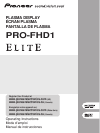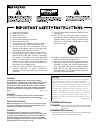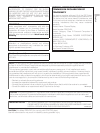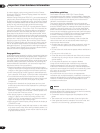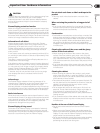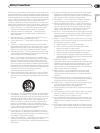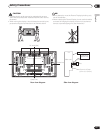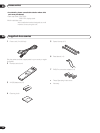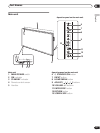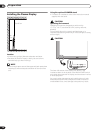
8
En
Important User Guidance Information
01
CAUTION
Panel sticking and after-image lag
• Displaying the same images such as still images for a long
time may cause after-image lagging. This may occur in the
following two cases.
1 After-image lagging due to remaining electrical load
When image patterns with very high peak luminance are
displayed for more than 1 minute, after-image lagging may
occur due to the remaining electric load. The after-images
remaining on the screen will disappear when moving images
are displayed. The time for the after-images to disappear
depends on the luminance of the still images and the time they
had been displayed.
2 After-image (lag image) due to burning
Avoid displaying the same image on the Plasma Display
continuously over a long period of time.
This includes those images displayed in the following screen
modes: multiscreen function, screen size 4:3, screen size FULL
14:9, screen size CINEMA 14:9, screen size Dot by Dot (except
when the input size is 1920x1080), and images with black
bands at top/bottom or right/left.
If the same image is displayed continuously for several hours,
or for shorter periods of time over several days, a permanent
after-image may remain on the screen due to burning of the
fluorescent materials. Such images may become less
noticeable if moving images are later displayed, but they will
not disappear completely.
• The energy save function can be set to help prevent damage
from screen burning (see page 29).
Image Retention
When a static image is left frozen on a display for several
hours, a faint imprint of the image, known as image retention,
can remain. This image retention may be temporary or
permanent. Although caused by different things, image
retention can occur on all display technologies, including
plasma and LCD. On today’s plasma displays, permanent
image retention is less of a worry. Most image retention can be
improved simply by watching moving video.
Image retention, also known as burn-in, can occur in all
phosphor-based display systems (including CRT television
systems -both direct view and projection- as well as plasma
display systems). Displaying the same still images for long
periods should be avoided as permanent image retention or
burn-in may occur. Recommended guidelines are as follows:
Do not display static images for long periods (such as still
images, fixed images from PC or TV game equipment, and/or
fixed images such as time of day indicator or channel logo
display).
Do not display content in the 4:3 aspect ratio (black or gray
bars on left and right side of content) or letter-box content
(black bars above and below content) for extended periods of
time, or use either of these viewing modes repeatedly within a
short period of time. This plasma display system is equipped
with multiple wide-screen viewing modes; use one of these
screen modes to fill the entire screen with content.
Displaying dark images after displaying still images for a
period of time may cause image retention. In most cases, the
image retention can be corrected by displaying bright images
for a similar period of time.
If you display still images on your plasma display system for
long periods of time, image retention may be irreparable.



